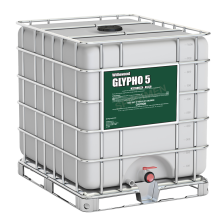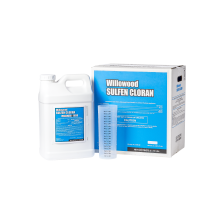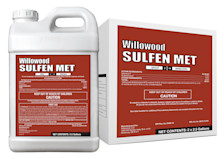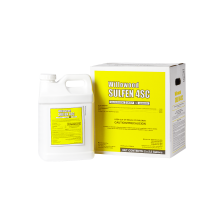Metolachlor 101: Everything Farmers Need to Know About Metolachlor
This guide includes the following sections:
What Is Metolachlor?
Metolachlor is a selective herbicide commonly used prior to crop emergence to control annual grasses and small-seeded broadleaf weeds in various row and specialty crops, including corn, cotton, soybeans, potatoes, sorghum, and tomatoes. It offers residual and systemic activity when applied pre-emergence. Other uses include weed management in turf, ornamental, rights of way, and forestry applications.
Metolachlor is available in two isomers: S-metolachlor and R-metolachlor.
Compared to the R-metolachlor isomer, S-metolachlor has greater herbicidal activity and requires lower use rates for effective weed control. For the most effective weed control, focus on products with higher ratios of S-isomer in their formulations. Some metolachlor formulations also contain safeners, which reduce the risk of crop injury, allowing the product to be used post-emergence in addition to pre-emergence in some cropping systems.
Metolachlor was first registered for use in the United States in 1976. Products that contain metolachlor as an active ingredient include the herbicides Acuron®*, Brawl II™, Dual II Magnum®, Prefix®*, and Cinch® ATZ*.
How Does Metolachlor Work?
Metolachlor is a Group 15 site-of-action herbicide — an inhibitor of very long-chain fatty acid synthesis — in the chloroacetanilide chemical family, which also includes acetochlor and pyroxasulfone. It works by inhibiting the growth of weed seedling shoots and is most effective when applied before weeds germinate. Some herbicides that contain metolachlor may provide more than 10 weeks of residual weed control.
Group 15 and Group 29 herbicides are collectively called seedling growth root inhibitors and include active ingredients like thiobencarb and ethofumesate.
How Long Does Metolachlor Take to Work?
Metolachlor is a systemic herbicide absorbed through the shoots and roots of germinating weeds and then translocated to the foliage. It works more slowly than most contact herbicides, including glufosinate. Complete weed kill times will vary depending on weed pressure, environmental conditions, and application rates.
Environmental conditions at the time of application can affect herbicide efficacy. Typically, systemic herbicides work more effectively when growing conditions favor plant growth. Herbicide activity improves when sufficient moisture is available following application and before weed emergence.
Metolachlor Application Rates
Metolachlor is primarily a pre-emergence herbicide typically applied just before or after planting or as a companion with a post-emergence herbicide like glyphosate or atrazine* to provide residual action. Typical use rates for GCS S-Metolachlor 82.4% EC applications in corn are provided below.
See the product label for complete application rate recommendations and suitable tank mix partners.
Metolachlor application rates will vary depending on the following:
Product applied
Application timing
Soil characteristics and organic content
Crop
Targeted weed species
Weed pressure
Learn how residual herbicides can help support season-long weed control.
How to Tank Mix with Metolachlor
Metolachlor can be tank-mixed with other herbicide active ingredients for broad-spectrum weed control and to manage emerged weeds in post-emergence applications. Glyphosate and atrazine are common tank-mix partners for managing grass and broadleaf weeds in corn crops.
The pesticide applicator is responsible for ensuring that all products are registered for their intended use. Applicators should follow label requirements involved in tank mixing, including use limits and mixing instructions. Some common metolachlor tank-mix partners for corn and soybean applications are listed below.
Metolachlor Tank Mixes for Pre-Plant/Pre-Emergence Corn Applications
GCS S-Metolachlor 82.4% EC may be tank mixed with the following active ingredients (not an all-inclusive list) to broaden the weed control spectrum for pre-plant or pre-emergence field corn applications:
Metolachlor Tank Mixes for Post-Emergence Corn Applications
For post-emergence corn applications, GCS S-Metolachlor 82.4% EC may be tank-mixed with atrazine or glyphosate/glufosinate in tolerant hybrids to manage a broader spectrum of weeds. The label recommends applications before grass and broadleaf weeds pass the 2-leaf stage and before corn exceeds 12 inches in height. Herbicide efficacy may be reduced when applied to weeds larger than the two-leaf stage. All corn:
Glyphosate-resistant corn:
Glufosinate-resistant corn:
Several branded and generic metolachlor premix herbicides are available for use in corn, including Bicep II Magnum®*, Stalwart® Xtra*, Parallel® Plus*, and Meto 1.7 + Meso 0.22 + Atrzn 1.66 Value Pick*.
Metolachlor Tank Mixes for Pre-Plant/Pre-Emergence Soybean Applications
There are more metolachlor tank mix options in soybeans. Paraquat* and glyphosate can be used for burndown plus residual control in reduced or no-till systems. The following herbicides may be added for additional residual control (not an all-inclusive list):
Metolachlor Tank Mixes for Post-Emergence Soybean Applications
Metolachlor tank mixes that include the herbicides listed below can effectively control emerged weeds and extend the residual control of small-seeded broadleaves and grasses (this is not an all-inclusive list).
How can you get the most from your pre-emergent herbicides? Check out this video for tips.
Metolachlor Resistance Management
Metolachlor is a powerful tool for resistance management, especially in soybean production. It offers an additional mode of action for controlling pre-emerged weeds while enabling more flexibility and residual control in post-emergence applications.
A tank mix of metolachlor plus a protoporphyrinogen oxidase-(PPO) inhibiting herbicide is often recommended in fields where glyphosate-resistant Palmer amaranth is a problem. While only 10 weed species are resistant to Group 15 herbicides, growers must take steps to steward these herbicides and avoid overuse when possible to maintain metolachlor’s efficacy in managing resistant weed populations.
7 Tips to Slow the Development of Metolachlor-Resistant Weed Populations
Make timely herbicide applications when weeds are 4 inches or smaller
Use multiple sites and modes of action
Employ crop rotation to diversify herbicides
Use full herbicide rates and layered residuals to extend the window of weed control
Add effective adjuvants to improve spray performance and plant uptake
Scout fields after applications to verify the application was effective
Add cultural or mechanical weed control practices, including tillage where appropriate
Learn how to manage 5,000 pests through the FBN Pest Solutions pages.
Metolachlor Human and Environmental Safety Guidelines
Metolachlor Human Safety Guidelines
Ensure the safe use of metolachlor by following all label instructions, including these safety guidelines:
Do not enter treated areas during the restricted entry interval (REI), which is 24 hours for most registered metolachlor products.
When handling metolachlor, wear appropriate personal protective equipment (PPE), including a long-sleeved shirt, pants, chemical-resistant gloves, closed-toe shoes, socks, and protective eyewear.
Wash your hands after handling the herbicide and remove clothing and PPE immediately if the product gets on them.
Follow all label instructions to ensure the safe use of metolachlor.
Metolachlor Environmental Safety Guidelines
Metolachlor is mobile in soil; therefore, there is a risk of ground and surface water contamination when it is used. Applicators should follow all labeled guidelines regarding applications near sensitive ecological areas. Environmental safety guidelines for metolachlor include:
To reduce the risk of surface water contamination from metolachlor runoff water and sediment, use appropriate vegetative buffer strips between application areas and surface water features such as ponds, streams, and springs.
Avoid applications when rainfall or irrigation is expected to occur within 48 hours to reduce runoff potential.
Protect the forage and habitat of non-target organisms by following label directions intended to minimize spray drift.
Buy Metolachlor at FBN
Metolachlor is one of the most widely used pre-emergence herbicides in corn and soybean production due to its resistance management versatility and extended residual activity. When paired with other effective pre-emergence and post-emergence herbicides, it helps provide season-long protection against a broad spectrum of grass and broadleaf weeds.
FBN offers a complete portfolio of herbicides, including single active-ingredient metolachlor products and convenient premixes. With a user-friendly online platform, transparent pricing, and direct-to-farm delivery available on your schedule, FBN puts Farmers First®.
Related Resources
Acetochlor 101: Everything Farmers Need to Know About Acetochlor
Atrazine 101: Everything Farmers Need to Know About Atrazine
Bifenthrin 101: Everything Farmers Need to Know About Bifenthrin
Biostimulants 101: Everything Growers Need to Know About Biostimulants
Clopyralid 101: Everything Farmers Need to Know About Clopyralid
Clethodim 101: Everything Farmers Need to Know About Clethodim
Crop Nutrition 101: Everything Farmers Need to Know About Crop Nutrition
Fungicides 101: Everything Farmers Need to Know About Fungicides
Glyphosate 101: Everything Farmers Need to Know About Glyphosate
Glufosinate 101: Everything Farmers Need to Know About Glufosinate
Herbicides 101: Everything Growers Need to Know About Herbicides
Inoculants 101: Everything Farmers Need to Know About Inoculants
Insecticides 101: Everything Farmers Need to Know About Insecticides
Lambda-Cyhalothrin 101: Everything Farmers Need to Know About Lambda-Cy
Metolachlor: Everything Farmers Need to Know About Metolachlor
Nitrogen 101: Everything Farmers Need to Know About Nitrogen
Paraquat 101: Everything Farmers Need to Know About Paraquat
Copyright © 2014 - 2025 Farmer's Business Network, Inc. All rights Reserved. The sprout logo, “Farmers Business Network”, "Farmers First", “FBN”, “FBN Direct,” and “FieldGrip” are servicemarks, trademarks or registered trademarks of Farmer's Business Network, Inc.
The following Trademarks are the property of their Owners as listed, or their affiliates. Adama: Parallel; Amvac Chemical Corporation: Python, FirstRate; BASF Corporation: Sharpen,Kixor,Verdict; Bayer: Balance Flexx; ; Coreteva: Cinch,, SureStart; FMC: Authority; Syngenta: Acuron, Bicep II Magnum, Dual II Magnum, FlexStar, Fusilade, Prefix; Sipcam Agro U.S.A: Stalwart; Tenkoz: Brawl. All other trademarks are the property of their respective owners.
Acuron® is a restricted-use pesticide.
GCS Atrazine 4L is a restricted-use pesticide.
Balance® Flexx is a restricted-use pesticide.
Bicep II Magnum® is a restricted-use pesticide.
Cinch® ATZ is a restricted-use pesticide.
GCS Atrazine 4L is a restricted-use pesticide.
Meto 1.7 + Meso 0.22 + Atrzn 1.66 Value Pick is a restricted-use pesticide.
Parallel® Plus is a restricted-use pesticide.
Prefix® is a restricted-use pesticide.
Stalwart® Xtra is a restricted-use pesticide.
Sharpen® powered by Kixor® herbicide is a restricted-use pesticide.
Willowood Paraquat 3SL is a restricted-use pesticide.
*Restricted Use Pesticides due to acute toxicity. For retail sale to and use by certified applicators only – NOT to be used by uncertified persons working under the supervision of a certified applicator.
FBN Direct products and services and other products distributed by FBN Direct are offered by FBN Inputs, LLC and are available only in states where FBN Inputs, LLC is licensed and where those products are registered for sale or use, if applicable. If applicable, please check with your local extension service to ensure registration status. Nothing contained on this page, including the prices listed should be construed as an offer for sale, or a sale of products. All products and prices are subject to change at any time and without notice. Terms and conditions apply.
ALWAYS READ AND FOLLOW LABEL DIRECTIONS. It is a violation of federal and state law to use any pesticide product other than in accordance with its label. The distribution, sale and use of an unregistered pesticide is a violation of federal and/or state law and is strictly prohibited. We do not guarantee the accuracy of any information provided on this page or which is provided by us in any form. It is your responsibility to confirm prior to purchase and use that a product is labeled for your specific purposes, including, but not limited to, your target crop or pest and its compatibility with other products in a tank mix and that the usage of a product is otherwise consistent with federal, state and local laws. We reserve the right to restrict sales on a geographic basis in our sole discretion. You must have a valid applicator license to use restricted use pesticides. Please consult your state department of agriculture for complete rules and regulations on the use of restricted use pesticides, as some products require specific record-keeping requirements.
The material provided is for educational purposes only. It is not intended to be a substitute for specific agronomic, business, legal, investment or professional advice. Where specific advice is necessary or appropriate, consult with a qualified agronomist, financial planner, or investment manager. Neither Farmer's Business Network, Inc. nor any of its affiliates makes any representations or warranties, express or implied, as to the accuracy or completeness of the statements or any information contained in the material and any liability therefore is expressly disclaimed.









